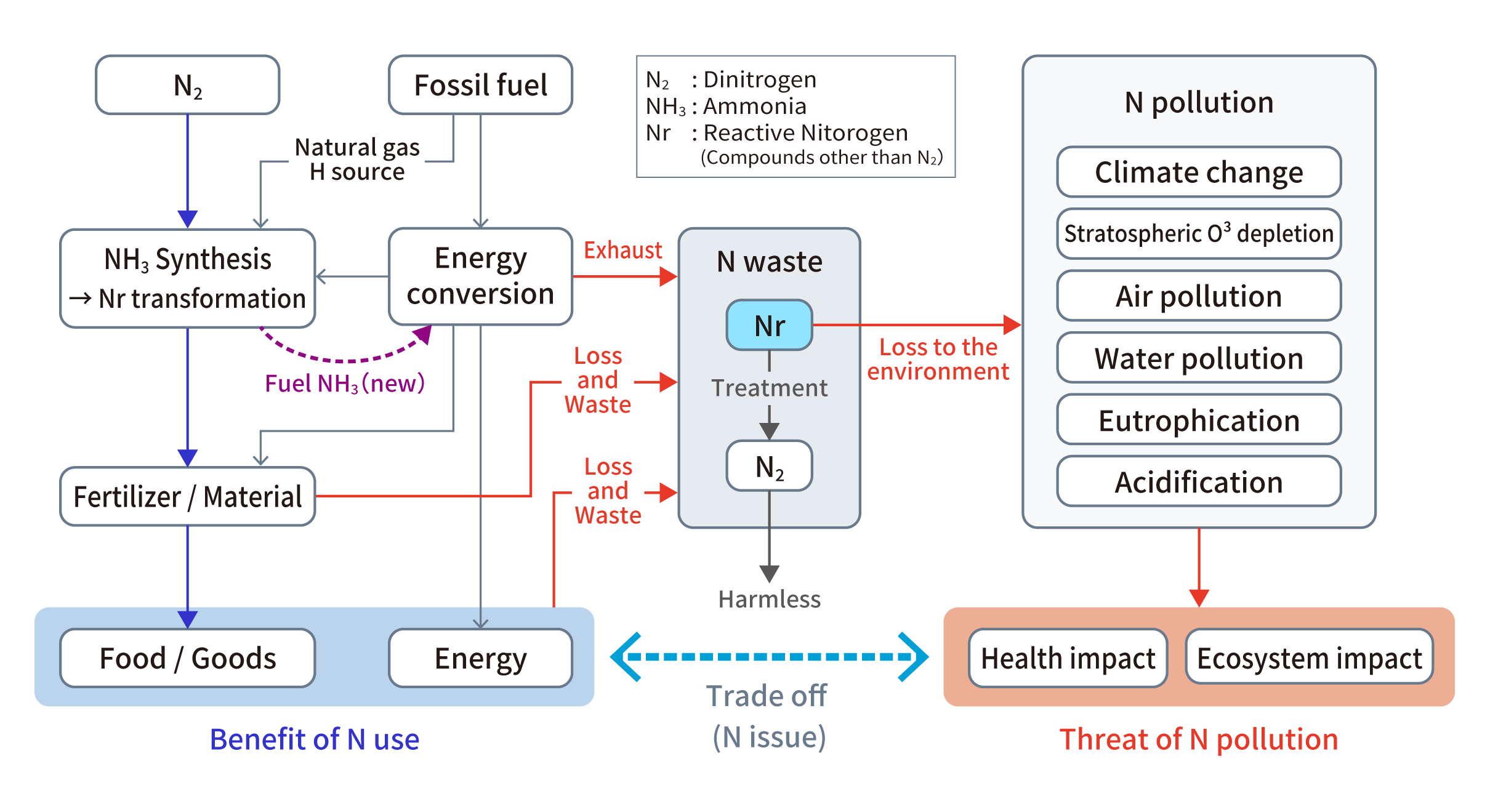About this project
Why do this research?
Nitrogen (N) is crucially important to living things as an essential component to form proteins and DNAs. Earth’s atmosphere is composed of 78% molecular nitrogen (dinitrogen, N2), N is everywhere as N2. However, N2 is inert and most of living things cannot utilize it directly. What is needed is reactive nitrogen (Nr, N compounds other than N2). Our eating is a way to intake N as proteins. We need Nr as fertilizers to produce sufficient food from limited areas of agricultural lands. The Haber–Bosch process, an artificial N fixation technology, developed in the early 20th century enables to create Nr from N2 as desired. The fixed Nr has provided great benefits to us as chemical fertilizers and industrial materials. In recent years, a new N use as fuels is also emerging.
On the other hand, much of Nr we use leaks into the environment. The low N use efficiency (NUE, here the ratio of N in products to the total N input) in our food system is the biggest cause. In addition to the low NUE in food production, consumption aspects such as the preference for livestock products with relatively low NUE and the loss of edible food also lower the whole system NUE. Fossil fuel combustion for energy conversion and waste incineration are also sources of Nr emissions. The environmental Nr loss causes various N pollution such as climate change, stratospheric ozone depletion, air pollution, water pollution, eutrophication, and acidification that threats human and ecosystem health. This trade-off, N use to earn benefits is accompanied by N pollution with threats, is called the N issue (Figure below). We owe the current Earth to future generations. This research is conducted to obtain integrated knowledge that will address the N issue and realize sustainable N use so that we and future generations can live with happiness.
Our N use (benefits) causes N pollution (threats)
Breakthroughs aiming for
Sustai-N-able Project aims for three breakthroughs.
- 1 N-DPSIR
- Developing a tool that enables quantitative assessment of the causal relationship between N use and N pollution using the concept of DPSIR (Driver–Pressure–State–Impact–Response).
- 2 N recognition
- Raising awareness among various stakeholders about the N issue, which is not yet well known compared to other global environmental issues.
- 3 Future N planning
- Creating inter- and trans-disciplinary knowledge for realizing sustainable N use of future generations with various stakeholders.
To achieve the three breakthroughs, members from a wide range of fields, including researchers in natural, social, and cultural sciences and experts in food culture, gather to tackle the following: elucidating the natural N cycle and ecosystem responses, elucidating N cycle in human society, building future N use scenarios, measuring the social N cost, evaluating the cost and benefit of the N issue, creating various educational opportunities on the N issue, and implementing the Future Design of sustainable N use.
As domestic activities, we establish several research sites, as well as collaborate with related programs and projects and local governments, agencies, and ministries in addition to nationwide analyses. As international activities, we collaborate with the International Nitrogen Initiative, the United Nations Environment Programme, the Task Force on Reactive Nitrogen/Convention on Long-range Transboundary Air Pollution, and others.
Research Units and main activities
Sustai-N-able project consists of four Research Units: Natural Cycling, Human Society, Economic Evaluation, and Future Planning. The first three units are responsible for interdisciplinary research, and the last unit is responsible for transdisciplinary research with various stakeholders while integrating the scientific knowledge collaborating with the other three units. The main tasks for each unit are shown below.
Natural Cycling Unit
Unit Leader: Keisuke Koba (Kyoto Univ.)
| Forest to coast | Elucidation of ecosystem functions (denitrification in particular) related to N cycles in forests, lakes, and coasts, N impacts on ecosystems, and watershed-scale N dynamics. |
|---|---|
| Nationwide survey | Nationwide survey: Analysis of mountain streamwater chemistry in cooperation with the Mountain Health Checkup Project (Kyoto University & mont-bell). |
| Analysis support | Provision of knowledge of natural N cycle to other units for analysis, and collaboration with other units to obtain necessary environmental information and data. |
| Environmental education | Collaboration with other units to provide knowledge of natural N cycle to environmental education and implementation of outreach activities together. |
Human Society Unit
Unit Leader: Kazuyo Matsubae (Tohoku Univ.)
| Food system | Analysis of N flows and environmental loss of each reactive N species in food systems. |
|---|---|
| Industry and energy sectors | Analysis of N flows in manufacturing and energy industries. |
| Trade-off and scenarios | Analysis of trade-offs between decarbonization and N pollution measures and construction of future scenarios |
| Analytical support tools | GIS and Input–Output analysis to support activities of other units. |
Economic Evaluation Unit
Unit Leader: Koichi Kuriyama (Kyoto Univ.)
| Social N cost | Evaluation of willingness to pay for N measures (e.g., mitigation of pollution and enhancement of natural purification function) using contingent analysis etc. |
|---|---|
| Analysis of behavior changes | Evaluation of effects of taxes, subsidies, nudges, and N footprint display methods, etc. |
Future Planning Unit
Unit Leader: Kentaro Hayashi (RIHN, Project Leader)
| Causal relationships | Cost–benefit analysis of the N issue and development of a visualization tool of the N issue to achieve the breakthrough 1, N-DPSIR. |
|---|---|
| Creating narratives | Leaflets, videos, reading materials, etc., and interactive seminars and workshops on the N issue (these experiences are also part of the narrative) to achieve the breakthrough 2, N recognition. |
| Future Design of N use | Practices with various stakeholders in Japan and the world and methodological development of N communication. |
| Education and inheritance | Creation of diverse educational opportunities for students, teachers, professionals, citizens, etc. focusing on linkages between food, agriculture, and the environment in both material and cultural aspects. |

